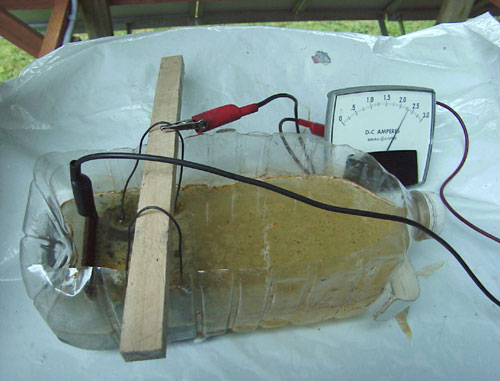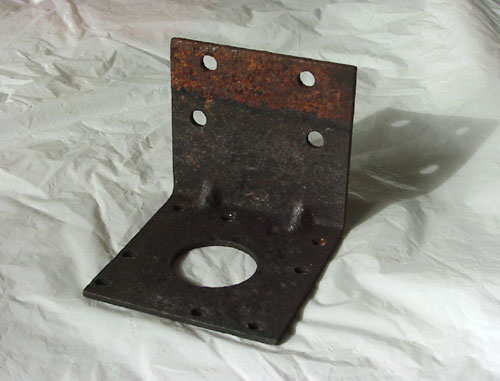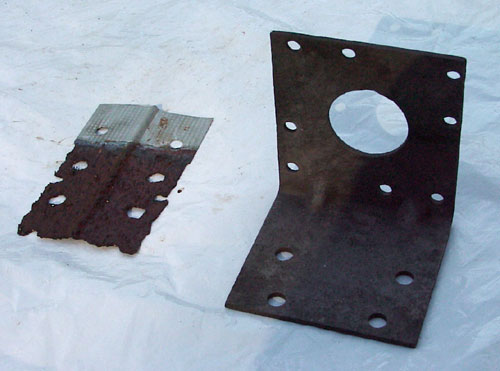Electrolysis Rust Removal
OK, new project: 10 meter amateur radio antenna.
Materials: Old CB base antenna the previous owners left behind.
New technique: Remove heavy rust from antenna mounting bracket without sanding, scraping, grinding, etc.
Here's how:
This antenna had been left out in the weather probably since it was new, first up on the roof where the antenna was initially used, then sitting around as junk in the yard for who knows how many decades. I tossed the antenna in a pile of "useful" metals that I didn't recycle when I cleaned up the yard after moving in. Last week, I decided to see if I could salvage the antenna and use it with my HF ham rig to give me a backup communications link into town in the event that the 2 meter repeater croaks.
The steel bracket for the antenna was badly rusted, so much so that it had deep pits where the rust had eroded the base metal. Normally, this would require a lot of effort to clean up, then it would need to be treated with phosphoric acid, then worked on some more before maybe being ready for primer. It would likely rust quickly, even with a topcoat of paint.
Then I remembered something that I read on a VW diesel forum some years back, a method of removing rust from steel parts using electrolysis. I decided to try it out. I hacked a hole in the side of a gallon drinking water bottle, half-filled it with spring water, sprayed some Easy-Off oven cleaner on the surface (because that's all I had that was a strong base, sodium hydroxide), and lit it up with a battery charger. After a few hours, it looked like it might be working somewhat, so I moved it out to the photovoltaic array and ran 24 volts into the electrodes. This produced more current, and intensified the results. Here's a photo of the process with an anode (+) of mild steel hanging from two bailing wires suspended by a stick of hardwood. The antenna bracket piece is on the left, connected to the negative (-) battery terminal. A little more than two amperes is flowing:

Removing the bracket from the bath and hosing it off with clear water shows how much of the rust has been removed:

The line near the top where the bracket changes color shows the difference between the untreated top of the bracket where it stood above the solution and therefore wasn't cleaned by the electric current.
The next day, I went into town, and while there, picked up some Arm & Hammer "Super Washing Soda", which is called for instead of the lye mixture I was using. I neutralized the lye with vinegar, and dumped it out. Refilling the bottle with clean water and a tablespoon full of washing soda gave even better results, more current flowed and the cleaning process accelerated.
Here's a piccy of the bracket after another hour or two in the bath, and after I shot it with the sand blaster just to pretty it up a bit:

The coupon of steel on the left is the metal I was using as an anode (positive pole). It is a clip of corner bead from the sheetrock work I've been doing in the house. Any old piece of steel or cast iron will work. I went through three pieces of this material to clean both bracket pieces. A larger, thicker piece of steel might have lasted a lot longer, but this was a trivial thing to replace during the process.
All I can say is "This WORKS!!!" At no time did I have to scrub the bracket with anything more than a worn-out kitchen scrubber to brush off the loose carbon that used to be hardened rust. I could even have done without the sand blasting, but since I have the gun, I decided to use it. The bracket (and it's mate) is now coated with cold galvanizing paint, with no rust underneath to spread.
You'll notice that I haven't given specific instructions for doing the electrolysis. That's because there is a PDF of the procedure over at the stovebolt.com site, and I'm just going to send you to that instead of trying to repeat it here:
http://www.stovebolt.com/techtips/rust/electrolysis.pdf
I tried to find a more technical description of what this process does, but didn't have any luck. The closest I came was treating rusted steel with phosphoric acid, which does the same thing chemically, but takes longer because it's less active:
http://en.wikipedia.org/wiki/Rust_removal#Rust_removal
I've used phosphoric acid to flash mildly rusted steel previous to painting, but never tried to do it without a lot of hard sanding with an angle grinder and sanding disk. Even that and hard wire brushing does not get into the pores, which is what the acid is for. I'm much happier with the results and lack of effort this method returned.
If you have rust to remove, this is worth looking into. You can do jobs of any size and it doesn't take any more equipment than a plastic container and a car battery charger. Check it out, try it and see!!!
Original material ©1996-2025 Mr. Sharkey | All rights reserved
